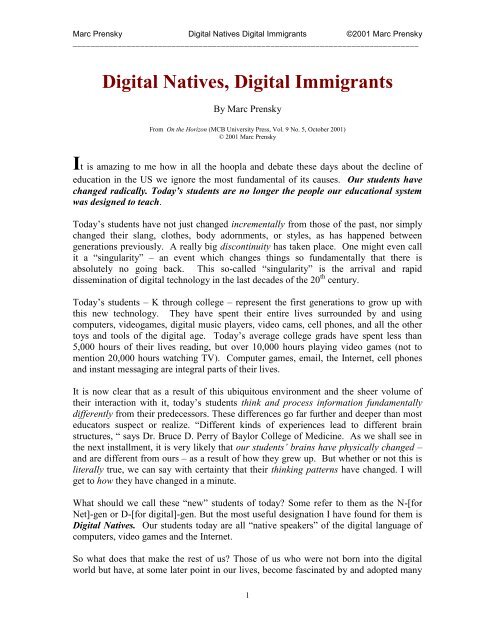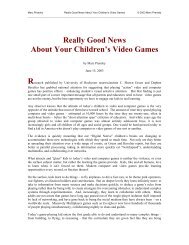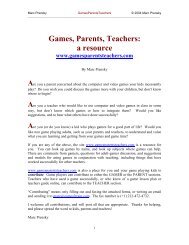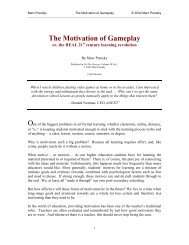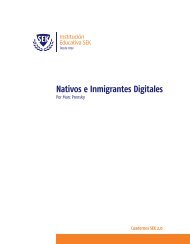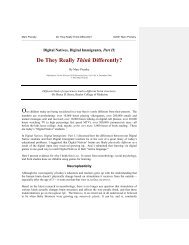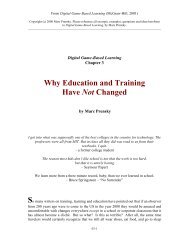Digital Natives, Digital Immigrants - Marc Prensky
Digital Natives, Digital Immigrants - Marc Prensky
Digital Natives, Digital Immigrants - Marc Prensky
Create successful ePaper yourself
Turn your PDF publications into a flip-book with our unique Google optimized e-Paper software.
<strong>Marc</strong> <strong>Prensky</strong> <strong>Digital</strong> <strong>Natives</strong> <strong>Digital</strong> <strong>Immigrants</strong> ©2001 <strong>Marc</strong> <strong>Prensky</strong><br />
_____________________________________________________________________________<br />
<strong>Digital</strong> <strong>Natives</strong>, <strong>Digital</strong> <strong>Immigrants</strong><br />
By <strong>Marc</strong> <strong>Prensky</strong><br />
From On the Horizon (MCB University Press, Vol. 9 No. 5, October 2001)<br />
© 2001 <strong>Marc</strong> <strong>Prensky</strong><br />
It is amazing to me how in all the hoopla and debate these days about the decline of<br />
education in the US we ignore the most fundamental of its causes. Our students have<br />
changed radically. Today’s students are no longer the people our educational system<br />
was designed to teach.<br />
Today‟s students have not just changed incrementally from those of the past, nor simply<br />
changed their slang, clothes, body adornments, or styles, as has happened between<br />
generations previously. A really big discontinuity has taken place. One might even call<br />
it a “singularity” – an event which changes things so fundamentally that there is<br />
absolutely no going back. This so-called “singularity” is the arrival and rapid<br />
dissemination of digital technology in the last decades of the 20 th century.<br />
Today‟s students – K through college – represent the first generations to grow up with<br />
this new technology. They have spent their entire lives surrounded by and using<br />
computers, videogames, digital music players, video cams, cell phones, and all the other<br />
toys and tools of the digital age. Today‟s average college grads have spent less than<br />
5,000 hours of their lives reading, but over 10,000 hours playing video games (not to<br />
mention 20,000 hours watching TV). Computer games, email, the Internet, cell phones<br />
and instant messaging are integral parts of their lives.<br />
It is now clear that as a result of this ubiquitous environment and the sheer volume of<br />
their interaction with it, today‟s students think and process information fundamentally<br />
differently from their predecessors. These differences go far further and deeper than most<br />
educators suspect or realize. “Different kinds of experiences lead to different brain<br />
structures, “ says Dr. Bruce D. Perry of Baylor College of Medicine. As we shall see in<br />
the next installment, it is very likely that our students’ brains have physically changed –<br />
and are different from ours – as a result of how they grew up. But whether or not this is<br />
literally true, we can say with certainty that their thinking patterns have changed. I will<br />
get to how they have changed in a minute.<br />
What should we call these “new” students of today? Some refer to them as the N-[for<br />
Net]-gen or D-[for digital]-gen. But the most useful designation I have found for them is<br />
<strong>Digital</strong> <strong>Natives</strong>. Our students today are all “native speakers” of the digital language of<br />
computers, video games and the Internet.<br />
So what does that make the rest of us? Those of us who were not born into the digital<br />
world but have, at some later point in our lives, become fascinated by and adopted many<br />
1
<strong>Marc</strong> <strong>Prensky</strong> <strong>Digital</strong> <strong>Natives</strong> <strong>Digital</strong> <strong>Immigrants</strong> ©2001 <strong>Marc</strong> <strong>Prensky</strong><br />
_____________________________________________________________________________<br />
or most aspects of the new technology are, and always will be compared to them, <strong>Digital</strong><br />
<strong>Immigrants</strong>.<br />
The importance of the distinction is this: As <strong>Digital</strong> <strong>Immigrants</strong> learn – like all<br />
immigrants, some better than others – to adapt to their environment, they always retain,<br />
to some degree, their "accent," that is, their foot in the past. The “digital immigrant<br />
accent” can be seen in such things as turning to the Internet for information second rather<br />
than first, or in reading the manual for a program rather than assuming that the program<br />
itself will teach us to use it. Today‟s older folk were "socialized" differently from their<br />
kids, and are now in the process of learning a new language. And a language learned later<br />
in life, scientists tell us, goes into a different part of the brain.<br />
There are hundreds of examples of the digital immigrant accent. They include printing<br />
out your email (or having your secretary print it out for you – an even “thicker” accent);<br />
needing to print out a document written on the computer in order to edit it (rather than<br />
just editing on the screen); and bringing people physically into your office to see an<br />
interesting web site (rather than just sending them the URL). I‟m sure you can think of<br />
one or two examples of your own without much effort. My own favorite example is the<br />
“Did you get my email?” phone call. Those of us who are <strong>Digital</strong> <strong>Immigrants</strong> can, and<br />
should, laugh at ourselves and our “accent.”<br />
But this is not just a joke. It‟s very serious, because the single biggest problem facing<br />
education today is that our <strong>Digital</strong> Immigrant instructors, who speak an outdated<br />
language (that of the pre-digital age), are struggling to teach a population that speaks<br />
an entirely new language.<br />
This is obvious to the <strong>Digital</strong> <strong>Natives</strong> – school often feels pretty much as if we‟ve<br />
brought in a population of heavily accented, unintelligible foreigners to lecture them.<br />
They often can‟t understand what the <strong>Immigrants</strong> are saying. What does “dial” a number<br />
mean, anyway?<br />
Lest this perspective appear radical, rather than just descriptive, let me highlight some of<br />
the issues. <strong>Digital</strong> <strong>Natives</strong> are used to receiving information really fast. They like to<br />
parallel process and multi-task. They prefer their graphics before their text rather than<br />
the opposite. They prefer random access (like hypertext). They function best when<br />
networked. They thrive on instant gratification and frequent rewards. They prefer games<br />
to “serious” work. (Does any of this sound familiar?)<br />
But <strong>Digital</strong> <strong>Immigrants</strong> typically have very little appreciation for these new skills that the<br />
<strong>Natives</strong> have acquired and perfected through years of interaction and practice. These<br />
skills are almost totally foreign to the <strong>Immigrants</strong>, who themselves learned – and so<br />
choose to teach – slowly, step-by-step, one thing at a time, individually, and above all,<br />
seriously. “My students just don‟t _____ like they used to,” <strong>Digital</strong> Immigrant educators<br />
grouse. I can‟t get them to ____ or to ____. They have no appreciation for _____ or<br />
_____ . (Fill in the blanks, there are a wide variety of choices.)<br />
2
<strong>Marc</strong> <strong>Prensky</strong> <strong>Digital</strong> <strong>Natives</strong> <strong>Digital</strong> <strong>Immigrants</strong> ©2001 <strong>Marc</strong> <strong>Prensky</strong><br />
_____________________________________________________________________________<br />
<strong>Digital</strong> <strong>Immigrants</strong> don‟t believe their students can learn successfully while watching TV<br />
or listening to music, because they (the <strong>Immigrants</strong>) can‟t. Of course not – they didn‟t<br />
practice this skill constantly for all of their formative years. <strong>Digital</strong> <strong>Immigrants</strong> think<br />
learning can‟t (or shouldn‟t) be fun. Why should they – they didn‟t spend their formative<br />
years learning with Sesame Street.<br />
Unfortunately for our <strong>Digital</strong> Immigrant teachers, the people sitting in their classes grew<br />
up on the “twitch speed” of video games and MTV. They are used to the instantaneity of<br />
hypertext, downloaded music, phones in their pockets, a library on their laptops, beamed<br />
messages and instant messaging. They‟ve been networked most or all of their lives. They<br />
have little patience for lectures, step-by-step logic, and “tell-test” instruction.<br />
<strong>Digital</strong> Immigrant teachers assume that learners are the same as they have always been,<br />
and that the same methods that worked for the teachers when they were students will<br />
work for their students now. But that assumption is no longer valid. Today‟s learners are<br />
different. “Www.hungry.com” said a kindergarten student recently at lunchtime. “Every<br />
time I go to school I have to power down,” complains a high-school student. Is it that<br />
<strong>Digital</strong> <strong>Natives</strong> can’t pay attention, or that they choose not to? Often from the <strong>Natives</strong>‟<br />
point of view their <strong>Digital</strong> Immigrant instructors make their education not worth paying<br />
attention to compared to everything else they experience – and then they blame them for<br />
not paying attention!<br />
And, more and more, they won‟t take it. “I went to a highly ranked college where all the<br />
professors came from MIT,” says a former student. “But all they did was read from their<br />
textbooks. I quit.” In the giddy internet bubble of a only a short while ago – when jobs<br />
were plentiful, especially in the areas where school offered little help – this was a real<br />
possibility. But the dot-com dropouts are now returning to school. They will have to<br />
confront once again the Immigrant/Native divide, and have even more trouble given their<br />
recent experiences. And that will make it even harder to teach them – and all the <strong>Digital</strong><br />
<strong>Natives</strong> already in the system – in the traditional fashion.<br />
So what should happen? Should the <strong>Digital</strong> Native students learn the old ways, or should<br />
their <strong>Digital</strong> Immigrant educators learn the new? Unfortunately, no matter how much the<br />
<strong>Immigrants</strong> may wish it, it is highly unlikely the <strong>Digital</strong> <strong>Natives</strong> will go backwards. In<br />
the first place, it may be impossible – their brains may already be different. It also flies<br />
in the face of everything we know about cultural migration. Kids born into any new<br />
culture learn the new language easily, and forcefully resist using the old. Smart adult<br />
immigrants accept that they don‟t know about their new world and take advantage of<br />
their kids to help them learn and integrate. Not-so-smart (or not-so-flexible) immigrants<br />
spend most of their time grousing about how good things were in the “old country.”<br />
So unless we want to just forget about educating <strong>Digital</strong> <strong>Natives</strong> until they grow up and<br />
do it themselves, we had better confront this issue. And in so doing we need to<br />
reconsider both our methodology and our content.<br />
3
<strong>Marc</strong> <strong>Prensky</strong> <strong>Digital</strong> <strong>Natives</strong> <strong>Digital</strong> <strong>Immigrants</strong> ©2001 <strong>Marc</strong> <strong>Prensky</strong><br />
_____________________________________________________________________________<br />
First, our methodology. Today‟s teachers have to learn to communicate in the language<br />
and style of their students. This doesn’t mean changing the meaning of what is important,<br />
or of good thinking skills. But it does mean going faster, less step-by step, more in<br />
parallel, with more random access, among other things. Educators might ask “But how<br />
do we teach logic in this fashion?” While it‟s not immediately clear, we do need to figure<br />
it out.<br />
Second, our content. It seems to me that after the digital “singularity” there are now two<br />
kinds of content: “Legacy” content (to borrow the computer term for old systems) and<br />
“Future” content.<br />
“Legacy” content includes reading, writing, arithmetic, logical thinking, understanding<br />
the writings and ideas of the past, etc – all of our “traditional” curriculum. It is of course<br />
still important, but it is from a different era. Some of it (such as logical thinking) will<br />
continue to be important, but some (perhaps like Euclidean geometry) will become less<br />
so, as did Latin and Greek.<br />
“Future” content is to a large extent, not surprisingly, digital and technological. But<br />
while it includes software, hardware, robotics, nanotechnology, genomics, etc. it also<br />
includes the ethics, politics, sociology, languages and other things that go with them.<br />
This “Future” content is extremely interesting to today‟s students. But how many <strong>Digital</strong><br />
<strong>Immigrants</strong> are prepared to teach it? Someone once suggested to me that kids should<br />
only be allowed to use computers in school that they have built themselves. It‟s a<br />
brilliant idea that is very doable from the point of view of the students‟ capabilities. But<br />
who could teach it?<br />
As educators, we need to be thinking about how to teach both Legacy and Future content<br />
in the language of the <strong>Digital</strong> <strong>Natives</strong>. The first involves a major translation and change<br />
of methodology; the second involves all that PLUS new content and thinking. It‟s not<br />
actually clear to me which is harder – “learning new stuff” or “learning new ways to do<br />
old stuff.” I suspect it‟s the latter.<br />
So we have to invent, but not necessarily from scratch. Adapting materials to the<br />
language of <strong>Digital</strong> <strong>Natives</strong> has already been done successfully. My own preference for<br />
teaching <strong>Digital</strong> <strong>Natives</strong> is to invent computer games to do the job, even for the most<br />
serious content. After all, it‟s an idiom with which most of them are totally familiar.<br />
Not long ago a group of professors showed up at my company with new computer-aided<br />
design (CAD) software they had developed for mechanical engineers. Their creation was<br />
so much better than what people were currently using that they had assumed the entire<br />
engineering world would quickly adopt it. But instead they encountered a lot of<br />
resistance, due in large part to the product‟s extremely steep learning curve – the software<br />
contained hundreds of new buttons, options and approaches to master.<br />
4
<strong>Marc</strong> <strong>Prensky</strong> <strong>Digital</strong> <strong>Natives</strong> <strong>Digital</strong> <strong>Immigrants</strong> ©2001 <strong>Marc</strong> <strong>Prensky</strong><br />
_____________________________________________________________________________<br />
Their marketers, however, had a brilliant idea. Observing that the users of CAD software<br />
were almost exclusively male engineers between 20 and 30, they said “Why not make the<br />
learning into a video game!” So we invented and created for them a computer game in the<br />
“first person shooter” style of the consumer games Doom and Quake, called The Monkey<br />
Wrench Conspiracy. Its player becomes an intergalactic secret agent who has to save a<br />
space station from an attack by the evil Dr. Monkey Wrench. The only way to defeat him<br />
is to use the CAD software, which the learner must employ to build tools, fix weapons,<br />
and defeat booby traps. There is one hour of game time, plus 30 “tasks,” which can take<br />
from 15 minutes to several hours depending on one‟s experience level.<br />
Monkey Wrench has been phenomenally successful in getting young people interested in<br />
learning the software. It is widely used by engineering students around the world, with<br />
over 1 million copies of the game in print in several languages. But while the game was<br />
easy for my <strong>Digital</strong> Native staff to invent, creating the content turned out to be more<br />
difficult for the professors, who were used to teaching courses that started with “Lesson 1<br />
– the Interface.” We asked them instead to create a series of graded tasks into which the<br />
skills to be learned were embedded. The professors had made 5-10 minute movies to<br />
illustrate key concepts; we asked them to cut them to under 30 seconds. The professors<br />
insisted that the learners to do all the tasks in order; we asked them to allow random<br />
access. They wanted a slow academic pace, we wanted speed and urgency (we hired a<br />
Hollywood script writer to provide this.) They wanted written instructions; we wanted<br />
computer movies. They wanted the traditional pedagogical language of “learning<br />
objectives,” “mastery”, etc. (e.g. “in this exercise you will learn…”); our goal was to<br />
completely eliminate any language that even smacked of education.<br />
In the end the professors and their staff came through brilliantly, but because of the large<br />
mind-shift required it took them twice as long as we had expected. As they saw the<br />
approach working, though, the new “<strong>Digital</strong> Native” methodology became their model<br />
for more and more teaching – both in and out of games – and their development speed<br />
increased dramatically.<br />
Similar rethinking needs to be applied to all subjects at all levels. Although most attempts<br />
at “edutainment” to date have essentially failed from both the education and<br />
entertainment perspective, we can – and will, I predict – do much better.<br />
In math, for example, the debate must no longer be about whether to use calculators and<br />
computers – they are a part of the <strong>Digital</strong> <strong>Natives</strong>‟ world – but rather how to use them to<br />
instill the things that are useful to have internalized, from key skills and concepts to the<br />
multiplication tables. We should be focusing on “future math” – approximation, statistics,<br />
binary thinking.<br />
In geography – which is all but ignored these days – there is no reason that a generation<br />
that can memorize over 100 Pokémon characters with all their characteristics, history and<br />
evolution can‟t learn the names, populations, capitals and relationships of all the 101<br />
nations in the world. It just depends on how it is presented.<br />
5
<strong>Marc</strong> <strong>Prensky</strong> <strong>Digital</strong> <strong>Natives</strong> <strong>Digital</strong> <strong>Immigrants</strong> ©2001 <strong>Marc</strong> <strong>Prensky</strong><br />
_____________________________________________________________________________<br />
We need to invent <strong>Digital</strong> Native methodologies for all subjects, at all levels, using our<br />
students to guide us. The process has already begun – I know college professors<br />
inventing games for teaching subjects ranging from math to engineering to the Spanish<br />
Inquisition. We need to find ways of publicizing and spreading their successes.<br />
A frequent objection I hear from <strong>Digital</strong> Immigrant educators is “this approach is great<br />
for facts, but it wouldn‟t work for „my subject.‟” Nonsense. This is just rationalization<br />
and lack of imagination. In my talks I now include “thought experiments” where I invite<br />
professors and teachers to suggest a subject or topic, and I attempt– on the spot – to<br />
invent a game or other <strong>Digital</strong> Native method for learning it. Classical philosophy?<br />
Create a game in which the philosophers debate and the learners have to pick out what<br />
each would say. The Holocaust? Create a simulation where students role-play the<br />
meeting at Wannsee, or one where they can experience the true horror of the camps, as<br />
opposed to the films like Schindler’s List. It‟s just dumb (and lazy) of educators – not to<br />
mention ineffective – to presume that (despite their traditions) the <strong>Digital</strong> Immigrant way<br />
is the only way to teach, and that the <strong>Digital</strong> <strong>Natives</strong>‟ “language” is not as capable as their<br />
own of encompassing any and every idea.<br />
So if <strong>Digital</strong> Immigrant educators really want to reach <strong>Digital</strong> <strong>Natives</strong> – i.e. all their<br />
students – they will have to change. It‟s high time for them to stop their grousing, and as<br />
the Nike motto of the <strong>Digital</strong> Native generation says, “Just do it!” They will succeed in<br />
the long run – and their successes will come that much sooner if their administrators<br />
support them.<br />
See also: <strong>Digital</strong> <strong>Natives</strong>, <strong>Digital</strong> <strong>Immigrants</strong> Part 2: The scientific evidence behind the <strong>Digital</strong> Native’s<br />
thinking changes, and the evidence that <strong>Digital</strong> Native-style learning works!<br />
<strong>Marc</strong> <strong>Prensky</strong> is an internationally acclaimed thought leader, speaker, writer, consultant, and game<br />
designer in the critical areas of education and learning. He is the author of <strong>Digital</strong> Game-Based<br />
Learning (McGraw-Hill, 2001), founder and CEO of Games2train, a game-based learning company,<br />
and founder of The <strong>Digital</strong> Multiplier, an organization dedicated to eliminating the digital divide in<br />
learning worldwide. He is also the creator of the sites ,<br />
and . <strong>Marc</strong> holds an MBA<br />
from Harvard and a Masters in Teaching from Yale. More of his writings can be found at<br />
. Contact <strong>Marc</strong> at marc@games2train.com.<br />
.<br />
6


